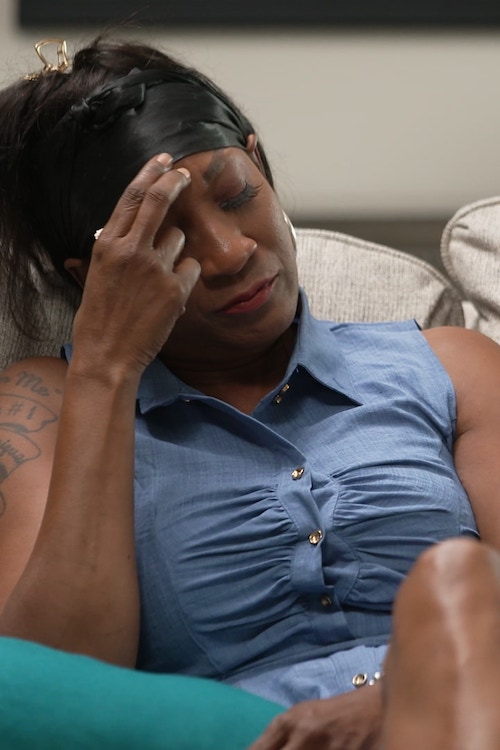technology becomes an excuse for intervention – reality blurred
In the second episode of A&E’s Digital Addiction, a new reality series similar to Intervention, one of the show’s “expert[s] on digital addictions,” Amanda Marino, tells a woman about a treatment center and says it’s “an opportunity to go to a residential program that addresses DEVICE-RELATED, SOCIAL MEDIA-RELATED mental health struggles such as yours.”
I put “device-related” and “social-media related” in screaming capital letters because those four words were clearly recorded later—I wouldn’t be surprised if it was over Zoom, that’s how awkward the audio is.
That ADR literally inserts digital addiction into another mental health issue, in this case childhood sexual abuse, which is what the show does, too.
“This is a great opportunity for you to get the healing you’ve needed since you were a child,” Marino says. It is a great opportunity, and there are people with real trauma and mental health challenges who are profiled.
Steffanie, for example, gets panic attacks when she’s not looking at her phone, and was sexually abused by her father at age 10, while her mother denies her experiences. Brandon, who leaves one date to look at his phone so he can plan another, has a very fraught relationship with his mother and family, rooted in their homophobia.
I’m glad Digital Addiction (A&E, Mondays at 10) treats their experiences seriously, and offers them help. But I don’t know why it had to be framed as addiction to technology.
While A&E’s Hoarders has participants who consent in order to get help with a crisis, Digital Addiction follows the Intervention model, by filming someone and then surprising them with an intervention. (The two shows are produced by the same company, GRB Studios.)
Here, though, there’s no life-or-death crisis, just the occasional suggestion that there are possible consequences.
While Hoaders helped bring awareness and attention to hoarding disorder, and Intervention focuses on substance abuse, Digital Addiction is focused on a disorder that is not yet something mental health professionals agree is a disorder.
There’s no current recognition or diagnosis of digital addiction. Instead, there is “[c]ontroversy around the diagnosis includes whether the disorder is a separate clinical entity, or a manifestation of underlying psychiatric disorders,” as Wikipedia summarizes. “Research has approached the question from a variety of viewpoints, with no universally standardised or agreed definitions, leading to difficulties in developing evidence based recommendations.”
In 2009, a psychiatrist published research asking, “Should DSM-V Designate “Internet Addiction” a Mental Disorder?” Their conclusion was that “It is not clear whether internet addiction usually represents a manifestation of an underlying disorder, or is truly a discrete disease entity.”
Digital Addiction is framed as if it’s about a disease, but the reality TV show’s actual focus is on the underlying issues.

Digital Addiction follows the same basic structure as Hoarders and Intervention: introducing two people, who talk about their lives while we also hear from their friends and family members.
We see them living their lives in scenes that feel grounded in reality but also created for our benefit, while on-screen title cards provide additional information and context.
For example, Brandon has a pillow for his phone, takes the phone into the shower, and also looks at it while on a “date” with someone the title cards tell us he met earlier that day.
He’s unapologetic about his phone usage, and that he has five dating apps and six social media apps, talks to 70 people a week, and goes on as many as for, uh, “dates” in a day. He tells us that he’s always on his phone: “I mean always. I have been on my phone at my grandmother’s funeral.”
One of his friends says, “There’s a fine line between checking your social media every few minutes or taking a selfie, and letting that just affect everything: your mood, what you’re doing that day, if you’re late to things, if you don’t show up at all.”
That’s a reasonable concern. Is it an actual disorder? Digital Addiction barely attempts to answer that.
After the subjects—two per episode—meet with an expert, in what basically constitutes a light therapy session, we get rather qualified mini-diagnoses.
“Based on my observation, I think Beth is an addict. She’s using the Internet and devices to interrupt her troubling thoughts,” Cory George tells the camera about one of the alleged digital addicts. (His website describes him as a “trauma mental health expert who has advocated for and assisted many with healing from the deleterious affects of various forms of trauma and other mental health challenges.”)
Dr. Rob Weiss, who runs a “Rehab for Sex, Porn, and Drug Addiction”, tells Brandon, “I think the past is holding you hostage.” He also tells him, “I think I underestimated how hurt and angry you are.”
In both cases, the alleged experts in digital addiction actually focus on other issues, treating tech use as just a symptom of trauma.
Both of the episode-one subjects break down surprisingly quickly during the intervention, despite their reluctance. “I think it’s crazy that people I’ve known for a limited time see so much in me that I don’t see in myself,” Brandon says, crying.
Cory George tells us that “Sometimes people change because they’re just tired. They’re tired of the same feelings, tired of the same way. It’s not until we get completely exhausted doing the same thing that we say, I’ve had enough.”
That may be what we’re seeing, but then Digital Addiction breezes past what happens after the intervention. We get quick updates about whether someone went to rehab or not, or if they left early, or if they got some other kind of help, and get a quick final few words that often leaps so far past where they were that it feels shocking.

Early in each episode, we’re told that, similar to Intervention, and via on-screen text, that a person “has agreed to participate in a documentary about her use of digital technology. During filming, she will be assessed by an expert on digital addictions.”
The second episode, however, focuses on a 15-year-old, Matthew. I found myself wondering: Did he agree? Did he have a choice?
Interestingly, after focusing on him, the episode pivots to pointing out that his parents are also using technology a lot: his mom is a vlogger, his stepdad is a gamer, and there’s lots of staring at screens in the house.
Tamrah Barber, who’s identified onscreen (and on Instagram) as a “teen interventionist,” tells us that there’s “digital overuse across the family as a whole,” and assigns the family an evening of detox.
At the intervention, Barber suggests sending Matthew to treatment for two weeks. His mother, Lina, immediately objects, and says this is about their family, not about Matthew. “I believe this is all of our issue, and I want in-home therapy,” she says.
I give the show credit for including all of this conversation, and the push back. Yet it seems like part of Lina’s objection is in how all of this was framed: blaming her son, sending him away. There’s good reason to her to be fearful, especially not knowing where he’s going. After all, talk shows send rebellious teens to boot camp, where some die.
The conversation effectively suggests Lina’s participation on Digital Addiction was to address a family problem, but the show needed a single subject to fit the Intervention format, and Matthew, a 15-year-old, was chosen.
I felt similarly about the whole series. It needed a hook, so it’s wedging people’s stories into something—too much screen time!—that feels familiar to all of us.
Surprise: it worked. A&E’s language promoting the series is what got me interested, with a press release saying “our reliance on digital devices has never been stronger. It is a reality that has taken a toll on many people, with digital addiction rates skyrocketing to unprecedented levels.” The network takes credit: “A&E brings a growing mental health issue into the forefront with the new docu-series.”
I didn’t see that “mental health issue” in the two Digital Addiction episodes I watched, but I did see the episodes bring several instances of suppressed trauma to the forefront. And if the subjects got help for that, great, and if someone sees their own trauma in the show and gets help themselves, all the better.
But that doesn’t change how Digital Addiction feels constructed for our benefit, and is neither as urgent as Intervention nor as revealing as Hoarders.
Digital Addiction
Digital Addiction follows a well-worn formula, and offers help to people who’ve experienced trauma, but seems like a show in search of an idea. C+
What works for me:
- Connecting tech usage to other trauma and behavior
- Giving people support and help, even if they had to go on a TV show to get it
What could be better:
- Renaming the show something like Trauma SOS, because digital addiction is a symptom, not the cause
- Stop trying to manufacture a problem, as it seems to do with Matthew—and the show itself
- More time on the follow-ups








Gloss